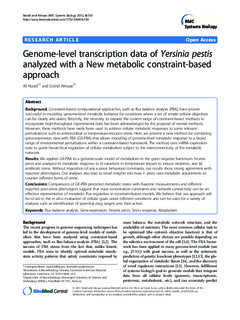| dc.contributor.author | Navid, Ali | |
| dc.contributor.author | Almaas, Eivind | |
| dc.date.accessioned | 2015-09-30T07:20:14Z | |
| dc.date.accessioned | 2015-10-28T14:46:36Z | |
| dc.date.available | 2015-09-30T07:20:14Z | |
| dc.date.available | 2015-10-28T14:46:36Z | |
| dc.date.issued | 2012 | |
| dc.identifier.citation | BMC Systems Biology 2012, 6(150) | nb_NO |
| dc.identifier.issn | 1752-0509 | |
| dc.identifier.uri | http://hdl.handle.net/11250/2358360 | |
| dc.description.abstract | Background: Constraint-based computational approaches, such as flux balance analysis (FBA), have proven
successful in modeling genome-level metabolic behavior for conditions where a set of simple cellular objectives
can be clearly articulated. Recently, the necessity to expand the current range of constraint-based methods to
incorporate high-throughput experimental data has been acknowledged by the proposal of several methods.
However, these methods have rarely been used to address cellular metabolic responses to some relevant
perturbations such as antimicrobial or temperature-induced stress. Here, we present a new method for combining
gene-expression data with FBA (GX-FBA) that allows modeling of genome-level metabolic response to a broad
range of environmental perturbations within a constraint-based framework. The method uses mRNA expression
data to guide hierarchical regulation of cellular metabolism subject to the interconnectivity of the metabolic
network.
Results: We applied GX-FBA to a genome-scale model of metabolism in the gram negative bacterium Yersinia
pestis and analyzed its metabolic response to (i) variations in temperature known to induce virulence, and (ii)
antibiotic stress. Without imposition of any a priori behavioral constraints, our results show strong agreement with
reported phenotypes. Our analyses also lead to novel insights into how Y. pestis uses metabolic adjustments to
counter different forms of stress.
Conclusions: Comparisons of GX-FBA predicted metabolic states with fluxomic measurements and different
reported post-stress phenotypes suggest that mass conservation constraints and network connectivity can be an
effective representative of metabolic flux regulation in constraint-based models. We believe that our approach will
be of aid in the in silico evaluation of cellular goals under different conditions and can be used for a variety of
analyses such as identification of potential drug targets and their action. | nb_NO |
| dc.language.iso | eng | nb_NO |
| dc.publisher | BioMed Central | nb_NO |
| dc.title | Genome-level transcription data of Yersinia pestis analyzed with a New metabolic constraint-based approach | nb_NO |
| dc.type | Journal article | nb_NO |
| dc.type | Peer reviewed | en_GB |
| dc.date.updated | 2015-09-30T07:20:14Z | |
| dc.source.volume | 6 | nb_NO |
| dc.source.journal | BMC Systems Biology | nb_NO |
| dc.source.issue | 150 | nb_NO |
| dc.identifier.doi | 10.1186/1752-0509-6-150 | |
| dc.identifier.cristin | 989910 | |
| dc.description.localcode | © 2012 Navid and Almaas; licensee BioMed Central Ltd. This is an Open Access article distributed under the terms of the Creative Commons Attribution License (http://creativecommons.org/licenses/by/2.0), which permits unrestricted use, distribution, and reproduction in any medium, provided the original work is properly cited. | nb_NO |
